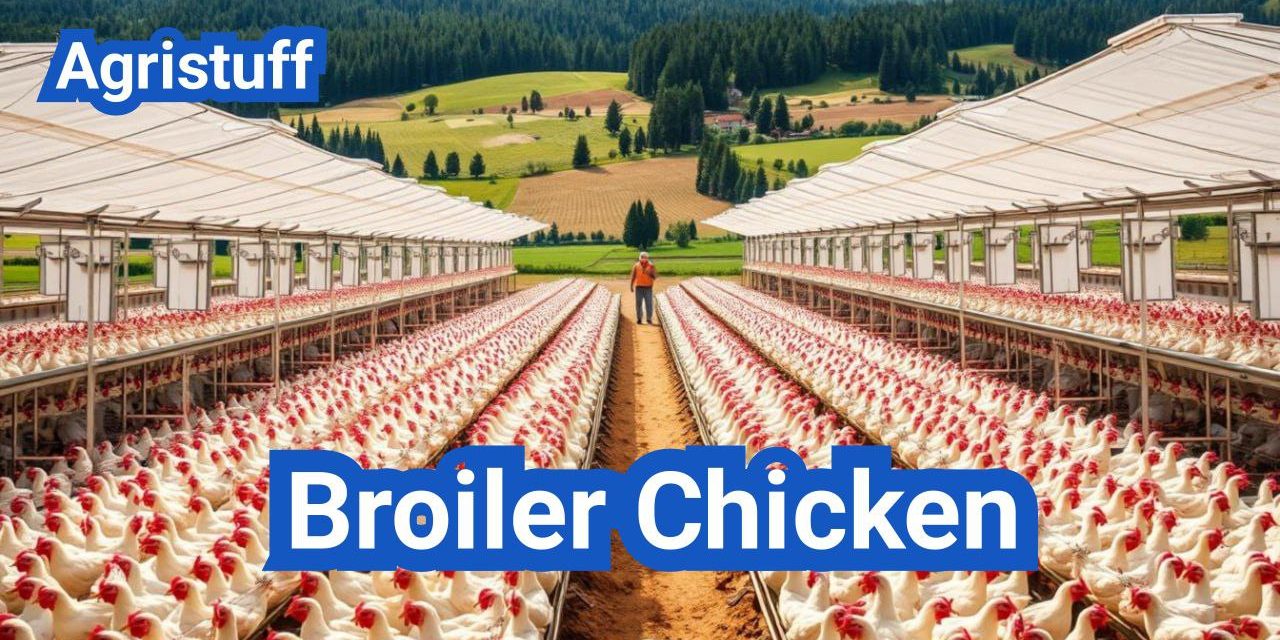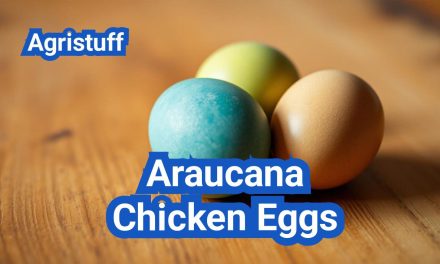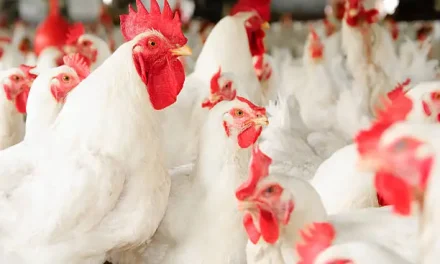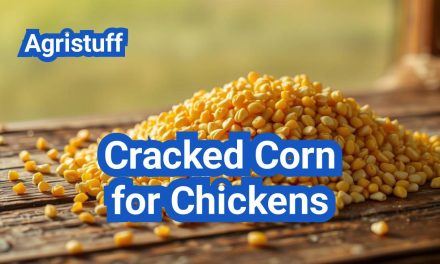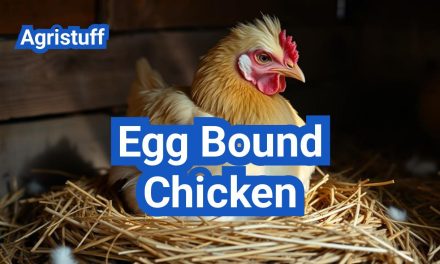Broiler chicken farming is a lucrative business that involves raising chickens specifically bred for meat production. These birds are genetically selected for their rapid growth rate, making them a staple in intensive farming operations worldwide.
The profitability of broiler chicken farming hinges on proper guidance and management practices, including suitable housing, nutritious feeding, and effective health management. By understanding the basics of meat production and implementing best practices, farmers can optimize their yields and maximize profits.
Key Takeaways
- Broiler chicken farming is a profitable venture when managed correctly.
- Genetic selection plays a crucial role in the rapid growth of broiler chickens.
- Proper housing, feeding, and health management are essential for successful meat production.
- Understanding the basics of broiler chicken farming is key to maximizing yields.
- Effective management practices can significantly impact the profitability of the farm.
What Makes Broiler Chickens Ideal for Meat Production
Understanding what makes broiler chickens ideal for meat production requires a look into their definition, characteristics, and history. Broiler chickens are specifically bred for their fast growth rate and high-quality meat, making them a staple in the poultry industry.
Definition and Characteristics of Broiler Chickens
Broiler chickens are defined by their rapid growth and are characterized by their white feathers and yellowish skin. They are bred to achieve market weight in a short period, typically within 5 to 7 weeks. This is achieved through selective breeding and advancements in poultry nutrition.
Key characteristics of broiler chickens include:
- Fast growth rate
- High feed conversion efficiency
- Broad breast and strong legs
History and Development of Modern Broilers
The history of broiler chickens dates back to the early 20th century when selective breeding began to focus on creating birds that grew faster and larger. Over the decades, breeding programs have significantly improved growth rates and meat quality.
The development of modern broilers involved crossing traditional breeds with commercial varieties to enhance their growth performance and meat yield. Today, breeds like the Cornish Cross are industry standards due to their exceptional growth rates and efficiency.
Broilers vs. Layer Chickens: Key Differences
Broiler chickens are distinct from layer chickens, which are bred for egg production. The main differences lie in their breeding purposes, growth rates, and physical characteristics.
| Characteristics | Broiler Chickens | Layer Chickens |
|---|---|---|
| Primary Purpose | Meat Production | Egg Production |
| Growth Rate | Fast (5-7 weeks to market weight) | Slower (ongoing production) |
| Physical Characteristics | White feathers, broad breast | Varied feather colors, slender build |
Understanding these differences is crucial for farmers and consumers alike, as it highlights the specialized nature of broiler chicken farming and its focus on producing high-quality meat efficiently.
Top Broiler Chicken Breeds for Commercial Success

Broiler chicken breeds like Cornish Cross and Ross308 have become industry standards due to their superior performance. The right breed can significantly impact the profitability and efficiency of commercial poultry farming operations.
Cornish Cross: Industry Standard Explained
The Cornish Cross is one of the most widely used broiler chicken breeds in commercial poultry farming. It is known for its fast growth rate, reaching market weight in as little as 5-6 weeks. This breed is a cross between the Cornish and White Rock chickens, combining the muscularity of the Cornish with the laying ability of the White Rock.
Key advantages of the Cornish Cross include its efficient feed conversion ratio and high yield, making it a preferred choice among commercial farmers.
Commercial Varieties: Ross308 and Cobb500
Ross308 and Cobb500 are other popular broiler chicken breeds used in commercial farming. Both are known for their rapid growth and efficient feed conversion.
- Ross308: Offers a high growth rate and is known for its robust health and welfare characteristics.
- Cobb500: Recognized for its fast growth and efficient feed conversion, making it a cost-effective option.
Both breeds are widely used in the industry due to their reliable performance and ability to thrive in various production systems.
Alternative Options: Freedom Rangers and Red Broilers
For farmers looking for alternative broiler chicken breeds, Freedom Rangers and Red Broilers offer different characteristics that may be beneficial depending on the production system and market demand.
| Breed | Growth Rate | Feed Conversion |
|---|---|---|
| Freedom Rangers | Moderate | Good |
| Red Broilers | Variable | Fair |
These breeds may offer added value for farmers targeting niche markets or looking for breeds with specific characteristics.
Starting Your Broiler Chicken Farm: Initial Planning
The success of a broiler chicken farm begins with thorough initial planning. This stage is crucial as it sets the foundation for the entire operation, influencing productivity, profitability, and sustainability.
Determining Your Production Scale
Deciding on the production scale is a critical first step in planning your broiler chicken farm. This decision will affect your investment, resource allocation, and market strategy. To determine your production scale, consider your available capital, market demand, and the resources you can manage effectively.
A small-scale operation might be suitable for beginners or those with limited resources, while a larger scale might be more appropriate for those with significant investment capacity and established market connections. It’s essential to start with a scale that aligns with your capabilities and gradually expand as your operation matures.
Land and Space Requirements
Assessing land and space requirements is another vital aspect of initial planning. The size of your farm will depend on your production scale, the housing system you choose, and the need for additional infrastructure such as feed storage and waste management facilities.
Adequate space is necessary not only for the chicken houses but also for future expansion and ensuring biosecurity measures are in place. Typically, a broiler chicken farm requires enough land for the chicken houses, feed storage, and waste management. The exact land requirement can vary based on the production scale and the technology used.
Legal Considerations and Permits
Understanding the legal considerations and obtaining the necessary permits is a critical step in establishing a broiler chicken farm. Regulations can vary significantly by location, so it’s crucial to consult with local authorities and agricultural departments to understand the specific requirements in your area.
Common legal considerations include zoning laws, environmental regulations, and animal welfare standards. Ensuring compliance with these regulations not only avoids legal issues but also contributes to the sustainability and social responsibility of your operation.
- Research local zoning laws and land-use regulations.
- Obtain necessary permits for construction and operation.
- Comply with environmental regulations regarding waste management.
- Adhere to animal welfare standards and biosecurity protocols.
By carefully planning your production scale, land and space requirements, and legal considerations, you can establish a solid foundation for your broiler chicken farm. This initial planning phase is crucial for the long-term success and profitability of your operation.
Broiler Chicken Housing Systems and Setup

The design and setup of broiler chicken housing systems play a significant role in determining the health and productivity of the flock. Effective housing is crucial for maintaining optimal conditions for chicken growth.
Modern Broiler House Designs
Modern broiler house designs prioritize bird welfare, efficiency, and environmental sustainability. These designs often feature controlled-environment housing that allows for precise regulation of temperature, humidity, and lighting.
Ventilation and Climate Control Systems
Adequate ventilation is essential for removing moisture, reducing ammonia levels, and maintaining a healthy atmosphere within the broiler house. Climate control systems work in tandem with ventilation to ensure optimal temperatures for broiler growth.
- Proper air exchange rates
- Temperature control
- Humidity management
Flooring and Bedding Materials
The choice of flooring and bedding materials significantly impacts broiler chicken welfare and farm hygiene. Common bedding materials include straw, wood shavings, and sand, each with its own advantages and considerations.
| Bedding Material | Advantages | Considerations |
|---|---|---|
| Straw | Cost-effective, good insulation | May be less absorbent |
| Wood Shavings | High absorbency, comfortable for birds | Can be expensive, may contain splinters |
| Sand | Excellent for heat stress reduction, durable | Heavy, requires special handling |
By focusing on these critical aspects of broiler chicken housing, farmers can create an environment that supports the health, welfare, and productivity of their flock, ultimately contributing to the success of their operation.
Essential Equipment for Successful Broiler Farming
Successful broiler farming relies heavily on the right equipment to ensure the health and productivity of the chickens. The efficiency of the farming operation, the welfare of the birds, and the overall profitability depend significantly on the quality and appropriateness of the equipment used.
Feeding and Watering Systems
Feeding and watering systems are critical components of broiler farming equipment. Feeding systems are designed to provide chickens with a consistent and efficient supply of feed. Modern feeding systems often include automated feeders that can be programmed to dispense feed at optimal times, reducing waste and ensuring that the chickens receive the nutrients they need for growth.
Watering systems are equally important, as access to clean water is vital for the health of the chickens. Automated watering systems help in maintaining hygiene and reducing labor costs. These systems can include nipple drinkers or bell drinkers, which are designed to minimize spillage and contamination.
Heating and Lighting Requirements
Heating and lighting are crucial for creating an optimal environment for broiler chickens. Heating systems are necessary, especially during the brooding phase, to maintain a warm temperature that promotes healthy growth. Common heating solutions include gas heaters, infrared heaters, and heat lamps.
Lighting also plays a significant role in broiler farming. Proper lighting can influence the growth rate and behavior of the chickens. Modern broiler houses often use LED lighting due to its energy efficiency and longevity. Lighting programs can be adjusted to simulate natural daylight patterns or to promote specific growth rates.
Monitoring and Automation Technology
The integration of monitoring and automation technology has revolutionized broiler farming. These systems allow farmers to monitor various parameters such as temperature, humidity, feed consumption, and water usage in real-time. Automation technology can adjust feeding times, lighting schedules, and ventilation rates based on the data collected, optimizing the growing conditions for the chickens.
Monitoring systems can also include sensors that detect early signs of disease or stress, enabling farmers to take prompt action. This proactive approach to health management can significantly reduce mortality rates and improve the overall efficiency of the farm.
By investing in the right equipment and leveraging technology, broiler farmers can enhance the productivity and sustainability of their operations, ultimately leading to better outcomes and increased profitability.
Broiler Chicken Nutrition: Feed Types and Strategies

Broiler chicken nutrition is a critical aspect of successful poultry farming, requiring careful consideration of feed types and strategies. The nutritional needs of broiler chickens vary significantly throughout their growth cycle, necessitating different types of feed at various stages.
Starter, Grower, and Finisher Feeds
Broiler chickens require three main types of feed: starter, grower, and finisher. Starter feed is used from day one to around 10-14 days of age and is formulated to support initial growth and development. It typically contains higher levels of protein and certain nutrients essential for young chicks.
Grower feed follows starter feed and is used until the chickens are about 28-30 days old. This feed is formulated to support continued growth while optimizing feed efficiency. The protein levels may be slightly lower than in starter feed, but it’s still nutrient-rich.
Finisher feed is used in the final stages of growth, typically from 28-30 days until processing. This feed is designed to promote optimal weight gain and prepare the birds for market. Finisher feeds often have adjusted nutrient profiles to meet the changing needs of the maturing chickens.
Feed Formulation and Key Ingredients
Feed formulation is a critical aspect of broiler chicken nutrition. The feed must be formulated to meet the specific nutritional requirements of the chickens at different stages of their growth. Key ingredients in broiler feeds typically include corn, soybean meal, and various supplements to ensure adequate protein, energy, vitamins, and minerals.
| Feed Type | Primary Ingredients | Nutritional Focus |
|---|---|---|
| Starter Feed | Corn, Soybean Meal, Vitamins | High Protein, Essential Nutrients |
| Grower Feed | Corn, Soybean Meal, Minerals | Balanced Protein, Energy |
| Finisher Feed | Corn, Soybean Meal, Supplements | Optimal Weight Gain, Market Preparation |
Feeding Schedules and Techniques
Implementing effective feeding schedules and techniques is crucial for maximizing the growth and health of broiler chickens. Feeding strategies may include ad libitum feeding, where feed is available to the chickens at all times, or restricted feeding programs, which can help manage growth rates and reduce costs.
The choice of feeding schedule depends on factors such as the breed of chicken, farm management practices, and market requirements. Monitoring feed consumption and adjusting feeding schedules as needed are essential for optimizing broiler chicken production.
Understanding Broiler Chicken Growth Rates

Understanding the growth patterns of broiler chickens is essential for optimizing farming practices. Broiler chickens are bred specifically for their rapid growth rate and efficient conversion of feed into meat.
Weekly Growth Expectations and Benchmarks
Broiler chickens exhibit rapid growth, especially during the initial weeks. Typically, a broiler chick grows from about 40 grams at hatch to around 2.5 kg in six weeks. Here’s a breakdown of weekly growth expectations:
| Week | Average Weight (grams) | Growth Rate |
|---|---|---|
| 1 | 150-200 | Rapid |
| 2 | 400-500 | Very Rapid |
| 3 | 900-1200 | High |
| 4 | 1500-1800 | High |
| 5 | 2200-2500 | Moderate to High |
| 6 | 2500-2800 | Moderate |
Feed Conversion Ratios Explained
The feed conversion ratio (FCR) is a critical measure of how efficiently broiler chickens convert feed into body weight. It’s calculated by dividing the total amount of feed consumed by the total weight gained. A lower FCR indicates better efficiency.
For example, if a broiler chicken consumes 3 kg of feed to gain 1 kg of weight, the FCR is 3. Modern broiler breeds have been optimized to achieve FCRs between 1.5 and 2.0, making them highly efficient.
Factors Affecting Growth Performance
Several factors can influence the growth performance of broiler chickens, including:
- Nutrition and feed quality
- Environmental conditions such as temperature and humidity
- Health status and disease management
- Breeding and genetics
- Management practices, including feeding schedules and housing conditions
Optimizing these factors can help achieve the best possible growth rates and overall performance.
Day-to-Day Broiler Chicken Management

Effective day-to-day management is crucial for the health and productivity of broiler chickens. Managing a broiler chicken farm involves a multitude of tasks that need to be performed daily to ensure the well-being of the birds and the overall success of the farm.
Daily Care Routine and Checklist
A daily care routine is essential for maintaining the health of broiler chickens. This routine should include checking the feeding and watering systems to ensure they are functioning properly, monitoring the temperature and ventilation in the broiler house, and inspecting the birds for any signs of illness or stress.
Creating a checklist can help farmers stay organized and ensure that all necessary tasks are completed. A typical daily checklist might include:
- Inspecting feed and water systems
- Monitoring temperature and ventilation
- Checking for signs of illness or stress in the birds
- Recording mortality rates
- Ensuring adequate lighting
Record Keeping Systems and Software
Accurate record keeping is vital for the successful management of a broiler chicken farm. Records should include data on feed consumption, growth rates, mortality rates, and any health issues that arise. This information can be used to identify trends and make informed decisions about farm management practices.
There are various record keeping systems and software available that can help streamline this process. Some popular options include:
| Software | Features | Benefits |
|---|---|---|
| FarmLogs | Field mapping, yield analysis, equipment tracking | Improved crop management, increased efficiency |
| Poultry Manager | Flock management, feed tracking, health monitoring | Enhanced flock health, better decision making |
| Granular | Farm management, financial analysis, operational insights | Streamlined operations, improved profitability |
Labor Requirements and Management
Managing labor is a critical aspect of running a broiler chicken farm. The number of workers required will depend on the size of the operation, with larger farms needing more staff to manage daily tasks.
Effective labor management involves ensuring that workers are properly trained, that tasks are delegated efficiently, and that labor laws and regulations are complied with. It’s also important to maintain good working conditions to ensure worker safety and satisfaction.
Some key considerations for labor management include:
- Training programs for new employees
- Clear task delegation and scheduling
- Compliance with labor laws and regulations
- Regular performance evaluations
Broiler Chicken Health and Disease Prevention

Maintaining the health of broiler chickens is crucial for successful meat production. Healthy birds not only ensure a profitable outcome but also contribute to a safe and sustainable food supply.
Common Diseases and Their Symptoms
Broiler chickens are susceptible to various diseases that can significantly impact their growth and mortality rates. Some of the most common diseases include:
- Infectious Bronchitis: Characterized by respiratory symptoms, such as coughing and sneezing.
- Avian Influenza: Can cause a range of symptoms from mild respiratory issues to severe systemic disease.
- Coccidiosis: A parasitic disease that affects the intestinal tract, leading to diarrhea and weight loss.
Early detection and diagnosis of these diseases are critical for effective disease prevention and management.
Vaccination Schedules and Administration
Vaccination is a key component of disease prevention in broiler chicken farming. The specific vaccination schedule can vary depending on factors such as the farm’s disease history and the prevalent diseases in the region.
- In ovo vaccination: Administered to chicks in the hatchery before they are sent to the farm.
- Spray vaccination: Applied to chicks or growers to protect against respiratory diseases.
- Drinking water vaccination: Delivered through the drinking water system to ensure easy administration.
It’s essential to work closely with a poultry veterinarian to determine the most effective vaccination program for your flock.
Working with Poultry Veterinarians
Poultry veterinarians play a vital role in maintaining the health of broiler chickens. They provide expert advice on disease prevention, diagnosis, and treatment.
Regular consultations with a poultry veterinarian can help:
- Develop customized health programs tailored to your farm’s specific needs.
- Monitor flock health and detect early signs of disease.
- Implement effective biosecurity measures to prevent disease introduction and spread.
By collaborating with a poultry veterinarian, you can ensure that your broiler chicken farm operates at optimal health and productivity levels.
Implementing Effective Biosecurity Measures

Effective biosecurity measures are the cornerstone of a successful and sustainable broiler chicken farming operation. Biosecurity refers to the practices and procedures put in place to prevent the introduction and spread of diseases within the farm.
A robust biosecurity plan is multifaceted, involving various aspects of farm management. It requires a thorough understanding of potential disease risks and the implementation of strategies to mitigate these risks.
Creating Comprehensive Biosecurity Protocols
Developing comprehensive biosecurity protocols is the first step towards securing your broiler chicken farm. These protocols should be tailored to the specific needs and risks associated with your operation.
- Identify potential entry points for disease-causing agents.
- Establish procedures for controlling access to the farm.
- Implement sanitation and disinfection practices.
- Develop a monitoring system to detect early signs of disease.
It’s essential to regularly review and update these protocols to ensure they remain effective against evolving disease threats.
Visitor and Worker Policies
Strict visitor and worker policies are critical components of a biosecurity plan. These policies help prevent the introduction of diseases into the farm through human contact.
Key elements include:
- Requiring all visitors to wear protective clothing and footwear.
- Restricting access to sensitive areas of the farm.
- Ensuring that all personnel understand and adhere to biosecurity protocols.
- Providing training on biosecurity practices for all farm workers.
Cleaning, Disinfection, and Downtime Procedures
Effective cleaning, disinfection, and downtime procedures are vital for maintaining a disease-free environment within the broiler house.
This involves:
- Thoroughly cleaning the broiler house between flocks.
- Using appropriate disinfectants to kill pathogens.
- Implementing downtime to allow for complete sanitization.
- Monitoring the effectiveness of these procedures.
By implementing these biosecurity measures, broiler chicken farmers can significantly reduce the risk of disease outbreaks, ensuring a healthier flock and a more sustainable farming operation.
Broiler Chicken Lifecycle: From Chick to Processing

Understanding the broiler chicken lifecycle is essential for successful meat production. This lifecycle encompasses several critical stages, from sourcing quality chicks to managing the brooding and growth phases, ultimately leading to processing.
Sourcing Quality Chicks from Hatcheries
The first step in the broiler chicken lifecycle is sourcing high-quality chicks from reputable hatcheries. This involves selecting hatcheries that maintain high standards of hygiene, genetics, and chick health. Quality chicks are crucial for ensuring the overall health and growth performance of the flock.
When sourcing chicks, farmers should consider factors such as breed suitability, vaccination history, and the hatchery’s disease control measures. Establishing a good relationship with a reliable hatchery can significantly impact the success of the broiler farming operation.
Brooding Phase Management (0-2 weeks)
The brooding phase is a critical period in the broiler chicken lifecycle, spanning from 0 to 2 weeks of age. During this time, chicks require careful management to ensure they grow healthily. Temperature control is vital, as chicks are sensitive to cold and require a warm environment.
- Ensure proper ventilation to remove moisture and prevent ammonia buildup.
- Provide adequate lighting to encourage feeding and activity.
- Monitor chick health closely, looking for signs of disease or stress.
Growth Phase Management (3-6 weeks)
Following the brooding phase, broiler chickens enter the growth phase, which typically lasts from 3 to 6 weeks of age. During this period, chickens grow rapidly, and their nutritional needs change. Feed formulation becomes critical to support optimal growth rates while maintaining health.
Farmers should focus on:
- Providing nutritionally balanced feed that meets the chickens’ growth requirements.
- Ensuring access to clean water at all times.
- Monitoring growth rates and adjusting management practices as necessary.
Effective management during the growth phase is crucial for achieving the desired weight and condition for processing, ultimately impacting the profitability of the broiler farming operation.
Meat Production Process and Facilities
The meat production process for broiler chickens involves several critical steps, from determining the optimal age and weight for processing to implementing humane handling and slaughter methods. Understanding these processes is crucial for farmers and producers aiming to deliver high-quality products while maintaining ethical standards.
Optimal Age and Weight for Processing
Broiler chickens are typically processed between 5 to 7 weeks of age, depending on the breed and production goals. The optimal weight for processing varies, but most commercial broilers are processed between 4 to 6 pounds live weight. Achieving the optimal age and weight is crucial for maximizing profitability while ensuring the birds are processed at the peak of their growth cycle.
Factors influencing optimal processing age and weight include:
- Growth rate of the breed
- Feed conversion efficiency
- Market demand for specific sizes
- Production costs
Humane Handling and Slaughter Methods
Humane handling and slaughter practices are essential for maintaining animal welfare and producing high-quality meat. Broiler chickens must be handled carefully to minimize stress and injury. This includes using appropriate catching methods, maintaining clean and safe transport conditions, and ensuring that slaughter facilities are designed to minimize bird stress.
Common humane slaughter methods include:
- Controlled atmosphere stunning
- Electrical stunning
- Captive bolt stunning
On-Farm vs. Commercial Processing Options
Farmers have the option to process their broiler chickens either on-farm or through commercial processing facilities. On-farm processing allows for greater control over the processing environment and can be more suitable for small-scale or niche producers. Commercial processing facilities, on the other hand, offer economies of scale and are typically better equipped to handle large volumes.
Considerations for choosing between on-farm and commercial processing include:
- Scale of production
- Available capital for infrastructure
- Regulatory compliance
- Market requirements
Ultimately, the choice between on-farm and commercial processing depends on the specific needs and goals of the producer, as well as the demands of their target market.
Broiler Chicken Economics and Profitability

Understanding the economics of broiler chicken farming is crucial for profitability. Broiler chicken economics encompasses various factors that influence the financial success of a farming operation.
Complete Cost Breakdown Analysis
A comprehensive cost breakdown analysis is essential for understanding the economics of broiler chicken farming. The main costs include:
- Feed costs: This is typically the largest expense, accounting for about 70% of total costs.
- Chick costs: The cost of purchasing chicks from hatcheries.
- Labor costs: Expenses related to employing staff for daily operations.
- Veterinary care: Costs associated with vaccinations, medications, and veterinary services.
- Equipment and infrastructure: Expenses for housing, feeding, and watering systems.
Current Broiler Chicken Pricing Trends
Broiler chicken pricing trends significantly impact profitability. Current market trends show fluctuations due to factors such as feed prices, consumer demand, and global market conditions. Farmers must stay informed about these trends to make informed decisions about production and pricing.
Calculating Return on Investment
Calculating the return on investment (ROI) is crucial for assessing the profitability of broiler chicken farming. To calculate ROI, farmers need to consider both the costs and revenues. The formula for ROI is:
ROI = (Gain from Investment – Cost of Investment) / Cost of Investment
By understanding the costs, staying abreast of pricing trends, and calculating ROI, broiler chicken farmers can make informed decisions to enhance profitability.
Marketing and Selling Your Broiler Chicken Products
A well-planned marketing approach is vital for broiler chicken producers to reach their target audience and achieve sales goals. Effective marketing involves understanding the target market, creating a brand identity, and choosing the right sales channels.
Direct-to-Consumer Sales Strategies
Direct-to-consumer sales allow broiler chicken farmers to sell their products directly to customers, potentially increasing profit margins. Strategies include:
- Farmers’ markets
- On-farm sales
- Online sales platforms
Wholesale and Retail Opportunities
Wholesale and retail sales involve selling products to intermediaries or directly to retailers. This can include:
- Supplying to local butcher shops
- Partnering with restaurants
- Selling to grocery stores
Pricing Strategies for Maximum Profit
Pricing strategies are crucial for maximizing profitability. Factors to consider include production costs, market demand, and competitor pricing.
| Pricing Strategy | Description | Potential Impact |
|---|---|---|
| Premium Pricing | Higher price for perceived higher quality | Higher profit margins |
| Competitive Pricing | Matching competitors’ prices | Maintaining market share |
| Penetration Pricing | Lower initial price to attract customers | Increased market share |
Scaling Your Broiler Chicken Business
Broiler chicken farming can be scaled effectively by understanding market demands and production capabilities. As the demand for poultry products continues to grow, scaling becomes an essential strategy for farmers looking to expand their operations.
Transitioning to Commercial Production
Moving from small-scale to commercial broiler chicken production involves several key steps. First, farmers must assess their current infrastructure and determine what upgrades are necessary to support larger operations. This may include expanding broiler houses, upgrading feeding and watering systems, and investing in more advanced ventilation and climate control systems.
Key Considerations for Commercial Production:
- Assessing and upgrading infrastructure
- Investing in advanced technology for efficiency
- Expanding market reach and sales channels
- Ensuring compliance with regulatory requirements
Contract Farming Opportunities
Contract farming is another viable option for scaling a broiler chicken business. This involves partnering with a larger company or integrator who provides the chickens, feed, and technical guidance, while the farmer provides the land, labor, and facilities.
Benefits of Contract Farming:
| Benefit | Description |
|---|---|
| Reduced Financial Risk | The contractor often covers initial costs such as chicks and feed. |
| Technical Support | Contractors typically provide technical guidance and support. |
| Market Access | Contractors have established markets, making it easier to sell products. |
Vertical Integration Possibilities
Vertical integration involves expanding a broiler chicken business by controlling more stages of the production process. This could mean integrating feed production, breeding, or processing into the operation.
Advantages of Vertical Integration:
- Increased efficiency and reduced costs
- Better control over the quality of the final product
- Potential for increased profitability
- Enhanced market competitiveness
By understanding and leveraging these strategies, broiler chicken farmers can effectively scale their businesses to meet growing demands and achieve long-term success.
Keys to Sustainable Broiler Chicken Farming Success
Sustainable broiler chicken farming is achieved by integrating various practices, including genetics, nutrition, health management, and biosecurity. By understanding and implementing these key elements, farmers can ensure a successful and profitable broiler chicken production.
The importance of selecting the right broiler chicken breed, providing optimal nutrition, and maintaining a healthy environment cannot be overstated. Effective biosecurity measures and day-to-day management are also crucial for preventing disease and promoting growth.
To achieve farming success, it is essential to stay informed about the latest developments in broiler chicken production and to continually assess and improve farming practices. By doing so, farmers can contribute to a sustainable food system while maintaining a profitable business.
By following the guidelines outlined in this comprehensive guide, farmers can establish a thriving broiler chicken operation that prioritizes animal welfare, environmental stewardship, and consumer satisfaction, ultimately leading to sustainable broiler chicken farming.
FAQ
What are broiler chickens?
Broiler chickens are chickens bred specifically for meat production, known for their fast growth rate and tender meat.
How are broiler chickens raised?
Broiler chickens are typically raised in controlled environments with optimized feeding and watering systems, and are harvested at a relatively young age.
How long does it take to grow a broiler chicken?
Broiler chickens are usually ready for processing between 5-7 weeks of age, depending on breed and production goals.
What are the problems with broiler chickens?
Broiler chickens can be prone to health issues due to their fast growth rate, and their welfare is a concern in intensive farming systems.
What is the difference between a broiler chicken and a normal chicken?
Broiler chickens are bred for meat production, whereas layer chickens are bred for egg production, and have different characteristics and growth rates.
Do broiler chickens lay eggs?
Broiler chickens are not bred for egg production, and are typically harvested before they reach laying age.
How long do broiler chickens live?
Broiler chickens are typically harvested between 5-7 weeks of age, although some breeds can live longer if not processed.
What are the welfare issues for broiler chickens?
Broiler chickens can experience welfare issues such as lameness, respiratory problems, and heat stress due to their fast growth rate and intensive farming conditions.
Is broiler chicken good or bad for you?
Broiler chicken can be a nutritious and healthy protein source if produced and cooked properly, but some farming practices can impact its nutritional quality.
How old are broiler chickens when slaughtered?
Broiler chickens are typically slaughtered between 5-7 weeks of age.
What are the benefits of raising broiler chicks from Freedom Ranger?
Freedom Ranger broiler chicks are known for their slower growth rate and more robust health, making them a popular choice for alternative and sustainable farming systems.
Which breed of baby broiler chicks is right for me?
The choice of broiler breed depends on production goals, market demand, and farming system, with popular breeds including Cornish Cross, Ross308, and Cobb500.
What is the difference between broiler and layer chickens?
Broiler chickens are bred for meat production, while layer chickens are bred for egg production, with distinct breeding purposes and characteristics.
Conclusion of: Broiler Chicken Farming
Broiler Chicken meat has become one of the cornerstone segments of U.S. agriculture, with nearly 9.33 billion broiler chickens raised in the United States during 2024, generating over 61.1 billion pounds of live-weight chicken meat and about $45.4 billion in total production value. Broiler Chicken represents the vast majority of poultry receipts in the U.S. sector and offers a high-turnaround pathway for both small- and large-scale producers.
Source: USDA Poultry Production Data
Why Broiler Chicken Farming Is Profitable in the USA
Broiler Chicken production delivers strong economic potential due to high domestic demand, competitive pricing at around 128 cents per pound wholesale (2024 average), and efficient growth cycles. Broiler Chicken farmers often benefit from narrow cost margins—for example, wholesale production costs have been measured at around $1.01/lb, with spot gross margins near $0.14/lb on a live- or whole-bird basis. This efficient margin structure and constant consumer appetite for chicken meat keep Broiler Chicken farming attractive for entrepreneurs, especially in regions like the Southeast where feed, labor, and infrastructure costs stay relatively low.
Source: USDA Poultry Sector Overview
Understanding Broiler Chicken Biology and Breeds
Broiler Chicken genetics have been selectively shaped for fast growth, high feed efficiency, and desirable meat yield. In modern U.S. lines, the typical feed conversion ratio (FCR) reaches approximately 1.6 kg of feed per kg of live body weight, with birds maturing in under 39 days. Such efficiency stems from controlled broiler-specific hybrid breeds like Cornish Cross or Ross 308. Broiler Chicken producers focus on starting with high-quality day-old chicks from reputable hatcheries (U.S. placed 9.46 billion chicks in 2024) to maintain consistent flock performance.
Source: Poultry Science Association Research
Broiler Chicken Housing and Biosecurity Basics
Broiler Chicken welfare and production performance depend heavily on adequate housing, ventilation, and sanitation. Inside growout facilities, maintaining optimal temperature (starts at ~90°F and tapers to 70°F over 5–7 weeks), controlled humidity (50–70%), and fresh bedding helps achieve proper growth without stress. Broiler Chicken houses should include curtained or tunnel-vent systems, uniform feeder space, and frequent litter management to limit ammonia and disease risks. Strict biosecurity protocols—fence perimeters, footbaths, visitor paths, and rodent control—are essential to protect the established flock of Broiler Chicken from pathogens.
Source: Ontario Poultry Farming Guidelines
Nutrition, Feed, and Feed Conversion Efficiency
Broiler Chicken feed cost typically accounts for 60–70% of total variable costs, so optimizing nutrition is crucial. Starter, grower, and finisher diets are formulated with high-quality protein, balanced amino acids, and soya/corn meal mix to support lean muscle growth. With a modern Broiler Chicken achieving FCR values around 1.6, well-planned phase feeding and feed additives such as phytase or probiotics can further reduce feed input per pound of gain. In the spring of 2025, Bern livestock studies showed that lower grain price volatility could reduce net cost by approximately 2 cents per live pound of Broiler Chicken.
Source: Feed Cost Management Strategies
Broiler Chicken Growth Cycle and Management Schedule
A standard Broiler Chicken growout is 5 to 7 weeks long. Birds are usually brooded under heat lamps or clover mats for the first 7–10 days, then transitioned to grower space. During this 7-week cycle, Broiler Chicken reach market weight (5.5–6.5 lbs live, about 4 lbs dress-out), which typically allows two to four flocks per year depending on downtime and flock overlapping. Proper lighting, vaccination (typically Marek’s, coccidiosis), and feed transition plans are critical to keeping feed conversions sharp and minimizing mortality in Broiler Chicken flocks.
Source: USDA Broiler Production Stages
Marketing, Distribution and Market Pricing for Broiler Chicken
Broiler Chicken producers in the USA sell through multiple channels: integrated processors, live-bird markets, wholesale poultry buyers, or direct-to-consumer on-farm outlets. Wholesale price benchmarks (e.g., Georgia Dock) hover around $1.30 per live pound, while farm-level margins depend on contract terms, bird weight, and quality grade. Approximately 15–16% of Broiler Chicken production is exported, mainly to markets in Mexico, the Philippines, and the Caribbean—though export share has declined slightly due to competition from Brazil, the world’s largest broiler exporter.
Source: USDA Poultry Trade Data
Cost Structure and Profit Margins in Broiler Chicken Farming
Estimating costs: day-old chicks range around $0.40–0.60 each, feed runs about $0.95–1.10 per pound of body weight, processing adds $0.30–0.50 per pound, and housing/labor overhead is about $0.10–0.15 per pound when amortized. Given a Broiler Chicken live weight of 5.5 lbs and an average cost of $1.01/lb, revenue near $1.15/lb results in a narrow but sustainable +$0.14/lb margin. At scale, selling 10,000 Broiler Chicken yields net returns between $4,000–6,000 per flock cycle depending on mortality and contract rate stability.
Source: Poultry Farming Economics
Risk Factors: Disease, Biosecurity, and Broiler Chicken Health
Broiler Chicken producers face risks such as disease outbreaks (avian influenza, coccidiosis, E. coli), feed price swings, and market volatility. Highly pathogenic avian influenza (HPAI) can disrupt integrated zones, prompting mandatory culls and market disruptions, although Broiler Chicken—being young and confined—tends to have lower disease incidence than longer-lived layers or turkeys. Strict protocols like all-in/all-out flock cycles, regular sanitation, rodent exclusion, and localized quarantine are key to mitigating Broiler Chicken health risks.
Source: USDA Biosecurity Guidelines
Scaling Up: From Backyard to Commercial Broiler Chicken Production
Transitioning from small-scale Broiler Chicken rearing to a commercial farm requires thoughtful planning. Backyard producers may start with a few hundred birds, but commercial operations reach into tens of thousands per flock. Proper licensing, USDA/FSIS inspection (if selling retail cuts), and compliance with zoning and environmental regulations become mandatory. Many U.S. farmers partner with integrators (Tyson, Pilgrim’s Pride, etc.), which supply chicks, feed and pay per pound—enabling Broiler Chicken production with lower upfront capital but less control over market choice.
Source: Small Flock Poultry Regulations
Sustainability, Welfare, and Consumer Trends in Broiler Chicken Meat
As consumers become more discerning, trends toward welfare-certified labels and sustainable production influence Broiler Chicken farming. Demand for antibiotic-free, organic, or slow-growing heritage broilers (e.g., Freedom Rangers) is rising. Producers can also reduce environmental footprint through efficient FCR, solar-powered broiler houses, and manure recycling as fertilizer. Transparency in sourcing and certifications adds value—especially among urban farm-to-table restaurants and online subscriptions purchasing Broiler Chicken directly from growers.
Source: Sustainable Poultry Farming Research
Final Thought
Broiler Chicken farming remains one of the most reliable and profitable meat-production ventures in the U.S., thanks to its rapid turnover cycle, highly efficient feed conversion (often 1.5–1.7 kg feed per kg body weight), and massive consumer demand, which generated around $45.4 billion in production value alone in 2024. While disease, feed cost volatility, and tightening regulations—particularly concerning welfare and antibiotic use—pose ongoing risks, these can be mitigated through strong biosecurity, precise nutrition strategies, and adoption of emerging technologies like precision livestock farming and sustainable energy systems.
Whether you’re planning a small backyard flock or gearing up for multi-flock commercial production, the key to consistent profitability is controlling costs (especially feed), maintaining health and welfare standards, and staying responsive to consumer trends—such as antibiotic-free or organic products—that add market value. Focusing on these fundamentals helps ensure that your Broiler Chicken enterprise thrives profitably in both traditional and niche market channels.
Source: USDA Poultry Industry Outlook

